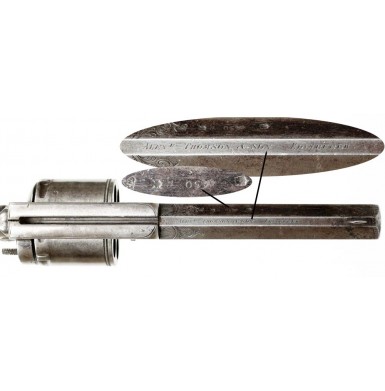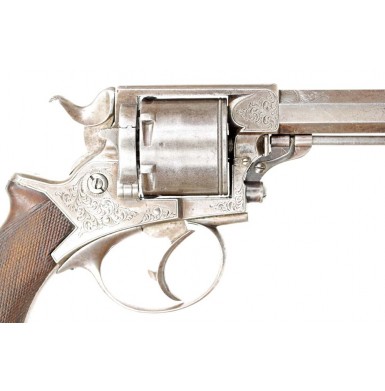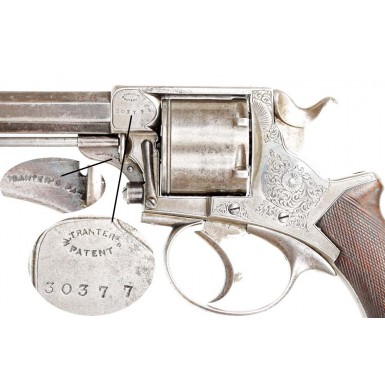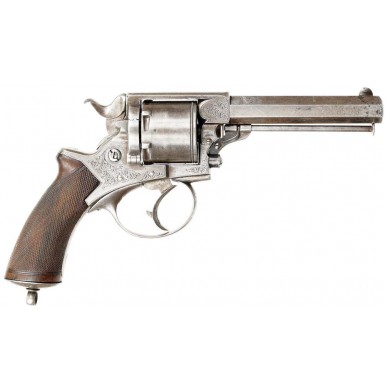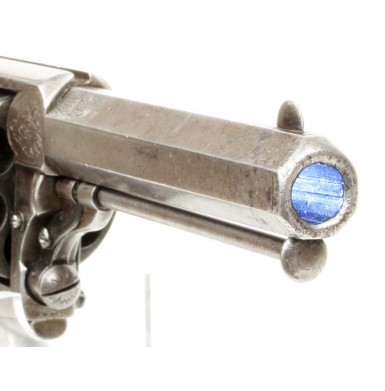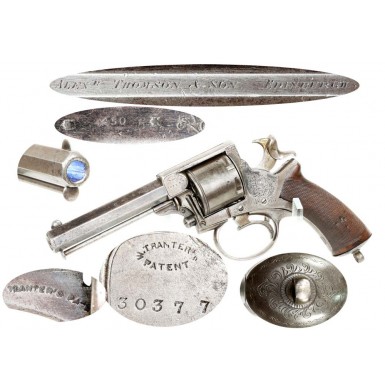William Tranter was one of the most prominent Gun, Rifle & Pistol Makers in the Birmingham trade during the mid-19th century. Tranter was born in 1816 and died in 1890. During his working life, his name became synonymous with quality handgun design and manufacture, although he produced small arms of all types and held patents related to all types of firearm actions. He went into business for himself circa 1840, after completing his apprenticeship with Hollis Brothers & Co, which he had begun in 1830. Tranter continued working actively in the gun trade until 1885, just five years before his death. After his decade of work learning the gun trade at Hollis Bros & Co (later Hollis & Sheath), in 1840 Tranter bought the established gun making business of Robert Dugard at 29 “ Whitehall Street. Over the next decade, he worked for himself and in joint ventures with his old employers John & Isaac Hollis as well as with Isaac Sheath. By 1850 he had located his primary business at 50 Loveday Street, where he was listed as having “shops, sheds, steam machinery, yard & premises” and became one of the first of the Birmingham gunmakers to utilize steam powered machinery. Tranter secured his first British patent related to firearms in October of 1849 when he registered a “pepperbox mechanism and lever catch for pistol locks”. In January 1853, he registered British Patent Number 212 (1853) for a pair of “self-cocking” pistol mechanisms and a safety mechanism. In December of the same year he registered designs for a double-action revolver mechanism, lubricated bullets and wadding, and a breech loading mechanism, all of which were covered by Patent Number 2921 (1853). In August of 1856 he registered the designs for a “double trigger revolver mechanism”, along with several other designs, all of which were covered by British Patent Number 1913 (1856). Tranter continued patenting firearm designs as late as 1887, after he had left active participation in the gun trade. One of Tranter’s most successful series of arms were his “self-cocking” percussion revolvers, which were initially introduced in 1853. The earliest revolvers utilized Robert Adams patent for a solid, one-piece frame and barrel that were machined from a single forging. Tranter’s initial production run of revolvers included both M-1851 Patent Adams style lock works, and Tranter's own patented lock works. The original “Tranter” type revolvers, known to collectors as 1st Model Tranters had no provision for an attached loading lever. Later production 2nd and 3rd Model guns offered improvements to the loading system with attached levers. All of these first three models were based on his “double-trigger” system (initially referred to as his “hesitating mechanism” on the early production guns), which utilized a second “trigger” under the trigger guard to rotate the cylinder and cock the hammer. The trigger inside the triggerguard was used to trip the sear and release the hammer. Tranter then introduced his 4th Model Tranter revolvers (circa 1856), which used a single trigger, and had what would today be called a conventional “double action” lock work. The Tranter patent revolver was the primary competitor with the Adams and Adams-Beaumont patent revolvers in England, and was also exported widely. Pre-Civil War Tranter revolvers are known with US retailer marks, indicating that his designs were at least somewhat successful in the United States. The majority of the retailer marked guns are from the south, with the largest majority of them being marked by New Orleans retailers. Based upon extant examples, the firm of Hyde & Goodrich (later Thomas, Griswold & Co) appears to have been the primary importer of Tranter Patent revolvers into the southern United States. Most of these retailer marked guns were sold cased with accessories, although some guns were certainly sold without the expensive casings and accouterments. During the course of the Civil War, it appears that the importation of Tranter revolvers was somewhat limited, at least in terms of Confederate central government purchases. However, period advertisements in the south and extant examples with southern provenance make it clear that the guns were imported by blockade-runners as speculative items for sale in the south. Despite his success both in England and abroad, William Tranter kept looking forward to new markets and designs. It was clear to him that the self-contained metallic cartridge was the wave of the future and he put significant efforts in design in that direction. His first cartridge offerings, as the height of the American Civil War period. He received English Patent #2067 (1862) for a variety of revolver improvements that he would subsequently include in his new line of cartridge revolvers, and the following year received English Patent #1862 (1863) for more improvements to cartridge revolvers. The first cartridge handguns to be introduced by Tranter were spur trigger, small caliber rimfire pistols in .230 and .320 calibers. The guns had solid frames, and were direct competitors to the hinged frame #1 and #2 revolvers from Smith & Wesson. However, Tranter knew that pocket sized spur trigger revolvers with low power cartridges were not going to win military contracts and he went to work on creating a larger, more powerful revolver. His offering was based upon his large frame 4th Model percussion revolver, and was initially manufactured in .442RF, although a .450 centerfire variant was offered fairly soon after the initial introduction. The most identifiable feature of the Model 1863 “Army” revolver was the side mounted, compound ejector mechanism that resembled a percussion revolver’s ramrod much more than an ejection system. The system was mounted on the right side of the barrel and frame and by lowering the lever, a plunger was pushed into the chamber push out the spent cartridge. The plunger was roughly the internal diameter of the casing, as Tranter had discovered that a simple ejector rod could actually punch through the bottom of a soft copper rimfire case, leaving the case hopelessly stuck in the cylinder chamber. A conventional loading gate at the rear of the recoil shield allowed the loading and unloading of the cartridges. A smaller framed variant of his Model 1863 was also introduced as the “House Defence” Revolver, in small calibers like .230, .297, .320 and .380. In typical Tranter style, the revolvers rarely bore his mark beyond a “Tranter’s Patent” mark on the frame and ejector system, and usually were left otherwise blank for retailer to apply his mark on the topstrap. A serial number and sometimes assembly numbers were usually the only other markings. With the introduction of the .450 CF version of the revolver, Tranter also introduced a floating firing pin in the frame of the gun, which was struck by the blunt nose of the hammer when the trigger was pulled. By 1868 Tranter had received a new patent for a series of improvements to the cartridge revolver (English Patent #282 of 1868) and his Model 1868 revolver quickly superseded the Model 1863. The new Model 1868 was also a solid frame, gate loading revolver based upon Tranter’s 4th Model double-action lockwork. The revolver had a somewhat fragile looking ejector rod mounted on a pivot under the barrel. To use the rod, the revolver was placed on half-cock the loading gate opened, and the rod swivels to the right, allowing it to be used to push empty cartridges out of the chambers. Unlike the ejector on the M-1863, the new rod did not have a large head, but was a more traditional thin rod ejector. The M-1868 was offered in compact, 5-shot pocket sizes, chambered for the .320RF and .380 CF and RF cartridges, and in a larger frame, 6-shot variant, chambered in .442RF, .450CF and .500CF. These revolvers remained in fairly constant production through the late 1870s, when the new Model 1878 and Model 1879 revolvers superseded them, with the production of most Tranter designs coming to an end in 1885, when he retired and formally leased his Aston gun factory to George Kynoch.
Offered here is a very scarce Tranter Model 1868 .450 Center Fire Revolver. Although these guns appear to have been made in greater numbers than their Model 1863 predecessors, and were certainly manufactured for a longer period of time, they appear to be equally rare in the market place. The revolver bears the usual TRANTER’s PATENT mark in two-line, arched cartouche on the upper left side of the frame, just behind the barrel, over the serial number 30377. This number places the gun very early in the production run of M-1868s that is generally believed to have commenced at about serial number 30,000 and continued through about the 60,000 range. It appears that all Tranter revolvers were numbered consecutively, without regard to model, thus during the early days of M-1868 production, when M-1863 revolvers were being produced as well, it would not be uncommon for consecutive numbers to be different models. The revolver is also marked TRANTER’s PATENT in a single-line arc on the left side of the cylinder arbor pin release. The matching assembly number 21 is found on the bottom of the barrel (concealed by the ejector rod) and on the rear face of the cylinder. The top flat of the asymmetrical octagonal barrel is marked ALEXR THOMSON & SON EDINBURGH. The firm of Alexander Thomson and Son was established by Alexander Thomson at 3 Drummond Street in Edinburgh in 1820. Thomson was a gunmaker and retailer. In 1833 Thomson moved to 16 Union Place and in 1869 the firm became Alexander Thomson & Son, moving to new premises at 95 Princes Street, where they remained through 1875, relocating to 3 Hanover Street in 1876 and remaining there through the end of the firm’s existence circa 1878-1879. This time line correlates with the very low serial number (for this model) on the gun, indicating it was certainly produced circa 1868-69. The only other markings are the caliber mark 450 on the upper left angled flat of the barrel, along with Birmingham commercial proof marks, which are also found on the cylinder, between the chambers.
This Tranter Model 1868 Revolver is in VERY GOOD+ to NEAR FINE condition overall. The gun retains about 10%-15% of its original blued finish, mostly on the barrel with some blue in the protected areas of the frame. The balance of the gun has a smooth brownish gray patina with some darker age discoloration and minor surface oxidation. The revolver is free of any serious pitting, but does show some very scattered pinpricking and minor surface oxidation, most rom. The frame of the revolver is finely engraved with tight floral scrolls, both in front and behind the cylinder. The first 1” of each of the upper angled barrel flats engraved as well with a floral splay and shell motif. The front edge of the cylinder is engraved with a delicate boarder line pattern and a similar, but larger boarder line is engraved around the muzzle. The quality of the engraving is quite fine. Delicate floral scrolls also enhance the triggerguard, as well as the buttcap. While most Tranter revolvers prior to this model had flat topstraps, this one has a slightly convex topstrap with a sighting groove machined in it, giving the gun a much more “modern” appearance when compared to the percussion and early cartridge models. The revolver has a 5 1/8” octagonal barrel with a narrow top flat that gives the barrel a slightly peaked appearance. The gun is approximately 10 1/8” in overall length, and has a solid frame with a hinged loading gate on the right side of the frame that opens down and to the right. The barrel is rifled with five wide grooves and measures .440” groove-to-groove at the muzzle and .430” land-to-groove. The six-shot cylinder rotates clockwise, and the chamber mouths measure .446”, with the rear of the chambers measuring .484”. The chambers are not recessed to accept a cartridge rim. The double action mechanism functions flawlessly as does single action operation, and the revolver times, indexes and locks up exactly as it should. The under-barrel ejector system and loading gate both function appropriately as well. The bore of the revolver is in VERY GOOD+ to NEAR FINE condition, and remains mostly bright with some lightly scattered pitting along its length. The original round blade front sight is in place on top of the barrel, near the muzzle of the revolver and the original small lanyard ring is present in the buttcap. The one-piece checkered walnut grip is secured by two screws, one in the upper tang and one in the bottom of the gripstrap. The grip is in about VERY GOOD condition and remains solid and complete with no breaks, chips, cracks or repairs. The grip does show some light to moderate wear and some smoothing to the checkering, as well as some minor bumps and dings from handling and use. There is a small cluster of dings in the left-hand side of the grip. Otherwise the remains in very nice condition with no indication of sanding.
Overall this is a crisp condition example of a fairly uncommon Tranter Model 1868 .450 CF revolver. The gun shows some real-world use, but no abuse and remains 100% complete, correct and fully functional. It is a very nice example of a pattern of English revolver that is rarely found for sale in America. This is a great opportunity to own a very important transitional revolver design that helped to forge the path from percussion to cartridge revolvers in Great Britain.
SOLD


